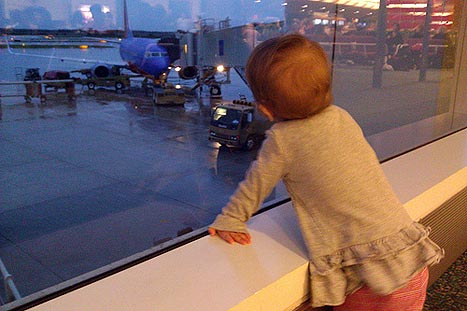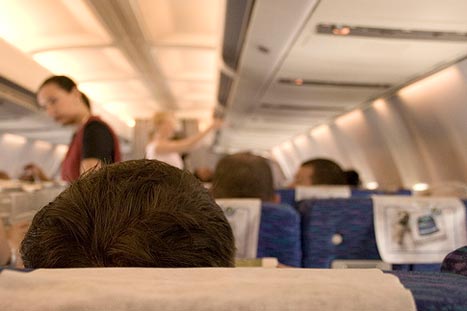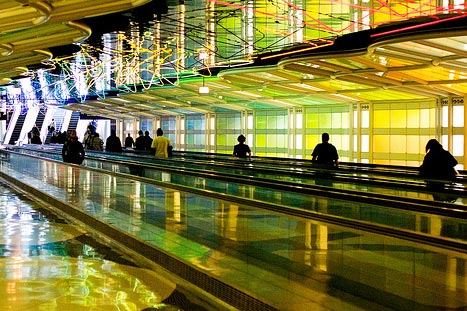But now that parent is you: how can you avoid fulfilling the other passengers' worst fears - and your own? Here are a few tips and tricks so that your tykes (and you) will survive the trip.

Children under the age of two years are allowed to fly as 'lap children' on most airlines - that means they can pay a reduced rate (sometimes nothing on domestic flights), but they do not get their own seat. You must purchase separate seats for children age two and up. In either case, make sure you make a reservation for your child.
If you are travelling with a lap child, it's worth inquiring about unoccupied seats on the airplane. If the flight is not full, attendants are usually willing to seat you strategically so you and your child have room to spread out. For this reason, it's useful to travel at off-peak times (though these are becoming increasingly rare).

Lap children are not allowed to be in a sling or baby carrier during the flight. It is advisable to keep them close to your body — preferably facing you — during take-off and landing. Some European carriers provide a special infant seat belt that attaches to the adult's seat belt. On longer flights, larger aircrafts sometimes have bassinets for infants in the bulkhead seats, which should be reserved well in advance.
While bringing your child on your lap entails a significant saving, it is not necessarily the easiest or safest way to fly. If you do purchase a separate seat for your child, he or she will be safest (and probably most comfortable) in an FAA-approved car seat. Regulations vary: some airlines do not allow rear-facing car seats and others do not allow very small infants to travel in car seats at all. So check your airline's regulations before flying.
As with any adventure, the key to success often lies in having the right gear. Any one of these items could be crucial to making your trip go more smoothly.
If you are bringing a car seat for your child, consider strapping it onto a Go-go Kidz Travelmate (gogobabyz.com). This ingenious invention eliminates the need for a stroller, allowing you to wheel your child through the airport, just like a roller bag. Once on board, the Travelmate can be stowed in the overhead compartment.
The Sit 'n' Stroll by Lilly Gold (lillygold.com) is another option that doubles as a car seat and stroller. Suitable for children up to 40lbs, it is essentially a car seat with collapsible wheels and handle. It is approved for use in a car or on an airplane — on some planes you can roll it right down the aisle.
If you do not need a car seat at your destination, a CARES harness (kidsflysafe.com) is a good idea for toddlers (22-44lbs). It fits in a carry-on bag and it is easy to install. The FAA-certified harness is useful for keeping squirmy toddlers buckled in during take-off, landing and times of turbulence.

So you know how to keep everybody safe on the airplane. Now comes the tricky part: keeping them happy. Toward this end, a little planning goes a long way.
This effort starts long before you get on the airplane, especially for toddlers. Make sure your child understands what's going to happen on this great adventure, including the security checkpoint, the airplane boarding and the flight itself. Books and DVDs about airplane travel can help to prepare your child. I'm a Good Little Traveler is a 'DVD Toolkit' that is specifically designed for this purpose.
The most important step you can take towards keeping your child happy is to plan your trip around her sleep needs. Does she doze amidst hustle and bustle or does she require a quiet, darkened room? If the former, try to fly during naptime and let her drift off into dreamland. Infants in particular are likely to fall asleep, especially if you nurse them during take-off. But you know your child better than anyone. If the commotion on the airplane is likely to keep her awake, you might be better off scheduling the flight in the morning, or whenever your child is freshest.

On your travel day, arrive early at the airport and let your child run and explore as much as possible before boarding. Take advantage of moving sidewalks, empty gates and play areas. Your child is going to have to sit still for a long time, so let him expend his energy now.
Keep a stash of snacks in your carry-on. Avoid sugar, but don't be shy about keeping your kid sated with protein-rich munchies. Milk is a magic potion that helps with ear pressure and provides a soothing sedative effect. Purchase it before you board, as not all flights have milk on board.
And, of course, keep a stash of surprises in your carry-on. Bring a few tried and true favourites, but be generous with books and toys that your kids have not seen.
Most importantly, always expect the worst, even as you hope for the best. And no matter what happens on the airplane, remember that it will be worth it once you arrive in your destination.